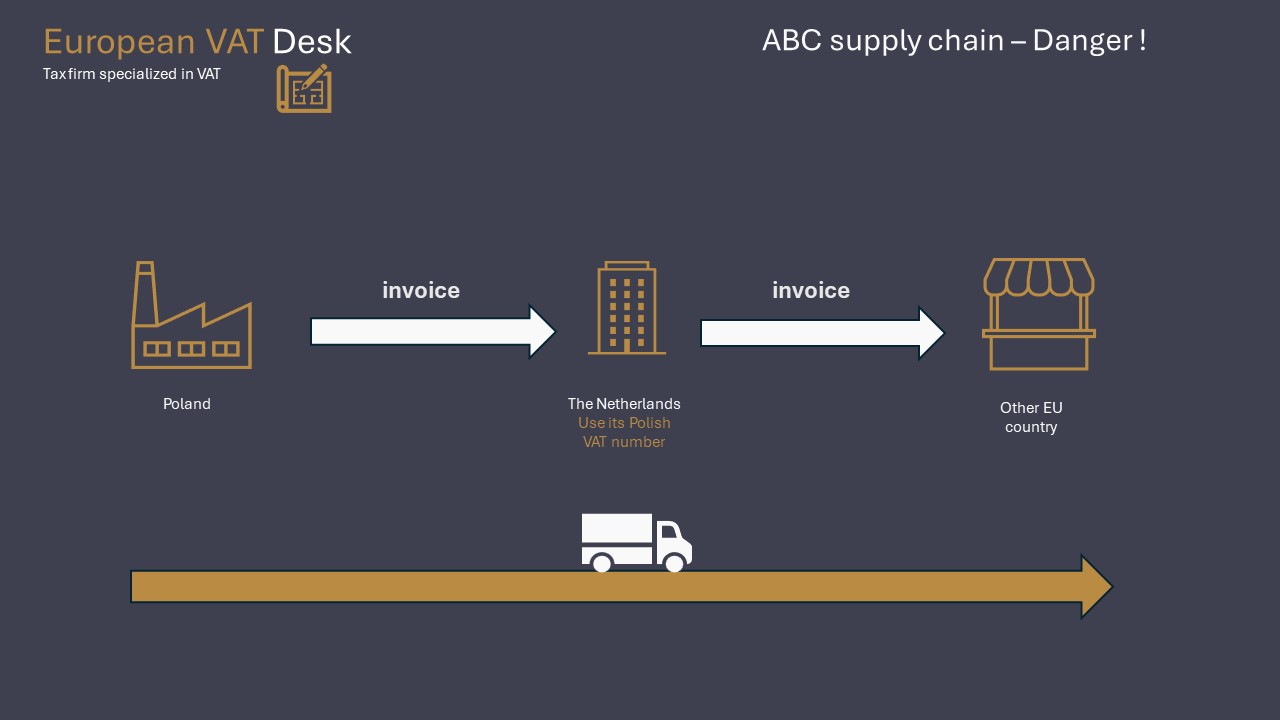The Author of the Article
To keep in mind
Participating in a supply chain sale is always a VAT hazard, especially when your company is in the middle of the chain. In this case, it is not always easy to determine in which relationship the intra-Community transport should be attributed.
This question is of vital importance in determining the correct treatment of the entire model.
A Dutch company has had bitter experience of this in Poland.
The case
A Polish supplier sells goods to a Dutch company which in turn sells them to European customers. The goods are shipped directly from Poland to the end customers in another EU country. This is a supply chain sale of the ABC type: A sells to B who sells to C.
It so happens that the Dutch company has a Polish VAT number. To avoid problems with the Polish tax authorities, it decides to charge the transport in the second relationship (BC):
- AB: internal delivery
- BC: intra-Community supply
To this end, it provides its Polish VAT number to its Polish supplier, who issues an invoice with Polish VAT. The Dutch company files its VAT return in Poland and applies for deduction and effective refund of the VAT paid.
The case in a nutshell

VAT Litigation
The company is subject to an audit procedure by the Polish administration. The Polish authorities consider that the transport was not correctly attributed to the BC relationship. The intra-Community transport is allocated to the first relationship AB so that the chain of transactions is treated as follows:
- AB: intra-Community delivery
- BC: internal delivery
-
However, the road to tax hell is sometimes paved with the best intentions. It is at this point that the Polish administration will simply loose it.
- The AB supply was treated by the parties as a domestic supply subject to Polish VAT. This was a mistake. The refund of the VAT credit is therefore refused. For the tax authorities, this is an intra-Community supply on the part of the Polish supplier, but it cannot be exempted because the Dutch company provided its Polish VAT number. This transaction is therefore subject to VAT in Poland.
- The intra-Community supply by the supplier is followed by an intra-Community acquisition by the Dutch purchaser. This acquisition is in principle subject to VAT in the country of arrival of the goods. Otherwise, it is taxed in the country where the purchaser is identified for VAT purposes, i.e. the VAT number under which the transaction takes place. This is what is known in VAT jargon as the "safety net". The trader is therefore subject to double taxation from the point of view of the Polish tax authorities. However, the taxable amount in the country of identification can be reduced to zero if the purchaser demonstrates that he has subjected the intra-Community acquisition to VAT in the country of arrival.
In this case, it was not the Dutch company that declared the intra-Community acquisition (but its own customer). In addition, it gave its Polish VAT number to its supplier. All the ingredients are therefore there for the safety net to be applied and for this intra-Community acquisition to be taxed in Poland.
The Dutch company, which did not want any trouble, ended up being charged 46% VAT (2 x 23%)!
It lodged several administrative complaints without result and then a legal appeal which ended up before the Court of Justice.
What does the Court of Justice say?
The Court first followed the reasoning of the Polish administration: the safety net is applicable even if the country of identification is also the country of departure of the transport.
But it then deviates from the Polish tax administration's viewpoint by stating that the intra-Community supply, once proven, is exempt from VAT in the country of departure. However, the Polish tax authorities had taken the view that the exemption could not apply on the basis of the Polish VAT number on the invoice. As long as the risk of loss of tax revenue is eliminated, thanks to the safety net, and the substantive conditions for intra-Community supply are met, there can be no question of claiming VAT on the intra-Community sale.
Source : C-696/20, B., 07/08/2022
The Expert's eye
In this case, the Dutch company narrowly avoided the double taxation sought by the Polish administration, but it is not out of the woods yet. It will only be able to reclaim Polish VAT if it corrects the entire model and proves that it has declared the intra-Community acquisition either in the country of arrival of the goods (which is unlikely given that these acquisitions have already been declared by its customers) or in another European country (by applying the simplified triangular regime).
There are several interesting elements to be reminded from this judgment:
- The attribution of transport remains the key issue in supply chain sales. The European regulation introduced in 2020 in all European countries (quick fixes), which was intended to reduce the risk of conflict on this issue, only partially resolves the issue.
- The Dutch company, rather than acting under its Polish VAT number and receiving an invoice with Polish VAT in order to avoid trouble with the Polish tax authorities, should have mastered the VAT mechanics of supply chain sales.
- Rigorous analysis of the VAT treatment of chain transactions is a better guarantee against VAT risks. Goodwill is not enough, especially in the face of tax authorities desperate for tax revenue.